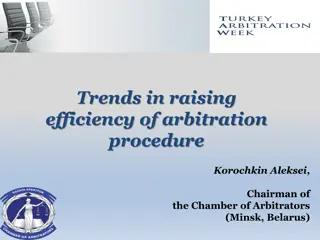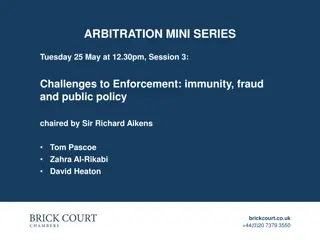Efficiency Tradeoff Between Class Adjudication and Individual Arbitration
Efficiency tradeoff between class adjudication and individual arbitration analyzes the enforcement of individual arbitration over class actions in the United States, highlighting the defense bar's advocacy for class action waivers and arbitration of individual claims. The Federal Arbitration Act's impact, Supreme Court rulings, and legislative actions influencing arbitration agreements are discussed, outlining the challenges and benefits of individual arbitration versus class-wide relief.
Download Presentation

Please find below an Image/Link to download the presentation.
The content on the website is provided AS IS for your information and personal use only. It may not be sold, licensed, or shared on other websites without obtaining consent from the author.If you encounter any issues during the download, it is possible that the publisher has removed the file from their server.
You are allowed to download the files provided on this website for personal or commercial use, subject to the condition that they are used lawfully. All files are the property of their respective owners.
The content on the website is provided AS IS for your information and personal use only. It may not be sold, licensed, or shared on other websites without obtaining consent from the author.
E N D
Presentation Transcript
Collective Redress in the United States H. Christopher Boehning Paul, Weiss, Rifkind, Wharton & Garrison LLP Law Made in Germany Symposium September 28, 2020 1
Efficiency Tradeoff Between Class Adjudication and Individual Arbitration Enforcement of Individual Arbitration Given the in terrorem effect of class actions, the defense bar has historically advocated for class action waivers and arbitration of individual claims. The Federal Arbitration Act ( FAA ) provides that a written arbitration provision in any contract involving commerce shall be valid, irrevocable, and enforceable, unless there are grounds in law or equity to revoke the arbitration agreement. The defense bar has enjoyed success in the U.S. Supreme Court, which has rigorously enforced arbitration agreements and class action waivers by their terms. In AT&T Mobility v. Conception (2011), the Court enforced a contract that waived class action litigation and arbitration rights, holding that the FAA preempts state unconscionability rules that would interfere with consensual arbitration agreements. See Epic Systems v. Lewis (2018) (enforcing arbitration clause and holding that collective bargaining under the National Labor Relations Act did not guarantee an employee class action); American Express v. Italian Colors (2013) (enforcing class action waiver despite the prohibitive cost of arbitrating individual antitrust claims). And in Stolt-Nielsen v. AnimalFeeds (2010) and Lamps Plus, Inc. v. Varela (2019), the Supreme Court held that class-wide arbitration must be expressly provided for in the contract. Silence or ambiguity in the contract forecloses class-wide arbitration, which lacks the speed and informality of individual arbitration. 2
Efficiency Tradeoff Between Class Adjudication and Individual Arbitration (continued) Enforcement of Individual Arbitration (continued) In addition, Congress and the Trump Administration have stuck down a federal regulatory agency s attempt to void arbitration agreements waiving class actions. For example, in July 2017, the Consumer Financial Protection Bureau ( CFPB ) published a rule prohibiting providers of certain financial products and services from using arbitration agreements to bar consumer class actions. A CFPB study found that arbitration clauses were being widely used to prevent consumers from seeking class-wide relief, and that consumers rarely file individual lawsuits or arbitrations. Congressional reaction was swift. That month, the U.S. House of Representatives passed a joint resolution of disapproval; then, in October 2017, the U.S. Senate voted to repeal the rule. In November 2017, President Trump signed a Joint Congressional Review Act resolution to invalidate the CFPB rule over concerns that it would increase credit costs for consumers and litigation costs for lenders. Thus, with support from the judicial, legislative, and executive branches, Corporate America has often been able to enforce agreements to arbitrate disputes individually. 3
Efficiency Tradeoff Between Class Adjudication and Individual Arbitration (continued) Individual Arbitration Issue (continued) One would expect (as the CFPB found) that, if plaintiffs must arbitrate individually, the cost of doing so would be prohibitive such that most claims will simply not be pursued. However, where plaintiffs have taken defendants up on the offer to arbitrate claims individually, it has turned out to be wildly inefficient and costly for some defendants. For example, the food delivery app Postmates is currently seeking to overturn an order requiring it to arbitrate 5,257 cases brought by delivery drivers who argue they were misclassified as independent contractors in violation of a federal statute. Postmates s agreement with its couriers mandates individual arbitration and delegates arbitrability issues to the arbitrator. But Postmates objects to plaintiff counsel s mass arbitration tactics that are forcing it to pay fees for each arbitration aggregating to millions of dollars. In a recent oral argument, a federal appellate panel was completely unsympathetic to this complaint because Postmates got what it contracted for: individual arbitrations instead of a consolidated class action. Companies in other industries (such as transportation, technology, and finance) are facing similar issues and inefficiencies, as courts continue to enforce arbitration agreements that the defendant companies themselves drafted and championed. 4
Implications of Creating a Higher Hurdle for Class Certification Historical Context Potentially lucrative contingency fees for class counsel (e.g., 33% of a common fund settlement) can cause enterprising plaintiffs lawyers to file strike suits based on a large injury, regardless of the merits of the case or the defendants culpability. U.S. class actions were historically easy to certify; the Federal Rules of Civil Procedure encouraged courts to decide class certification as early as practicable after commencement of the case, without adjudicating the merits. Some courts assumed the truth of the pleadings at the class certification stage, and/or resolved doubts in favor of class certification. Applying a low bar to class certification could transform an individual plaintiff s claims into claims on behalf of hundreds of thousands of plaintiffs, exponentially expand the defendants exposure into the billions of dollars, and create hydraulic pressure to settle the class action even when there is no merit to the underlying allegations. 5
Implications of Creating a Higher Hurdle for Class Certification (continued) Structural Reforms In recent years, the historically low bar to class certification has been heightened by structural reforms favorable to defense counsel. For example: Statutory Reforms: In 1995 and 2005 respectively, Congress passed the Private Securities Litigation Reform Act and the Class Action Fairness Act. Procedural Rule Changes: In 1998, Federal Rule of Civil Procedure 23 was amended to permit interlocutory appeals of class certification decisions. In 2003, the Rule was amended again to remove the directive that courts decide class certification [a]s soon as practicable, thereby deferring the certification decision until later in the life cycle of the class action. Judicial Evolution: In 2011, the U.S. Supreme Court held in Wal-Mart v. Dukes that class plaintiffs must prove by a preponderance of the evidence at the class certification stage that each element of Rule 23 has been met in fact even if that means proving a merits issue. The court must undertake a rigorous analysis before granting class certification, often including expert reports, a hearing, or a ruling on admissibility of evidence. 6
Implications of Creating a Higher Hurdle for Class Certification (continued) Abuse of Opt-Out Process Although defense counsel cheered these class action reforms, delaying the class certification decision has enabled opt-out plaintiffs to exploit the system. Prior to class certification, class members are not considered parties and are not required to do anything. Phillips Petroleum v. Shutts, 472 U.S. 797, 81 (1985). In addition, the statute of limitations on an underlying cause of action is automatically tolled upon the filing of a putative class action. In practice, opt-out actions are brought by well-counseled claimants who have the economic incentive, means, and sophistication to litigate individually. These strategic litigants can sit on the sidelines until the class action settles, or at least until after class certification has been decided and the period to opt out ends. By opting out so late in the game, plaintiffs may use their due process rights as a bargaining chip to force defendants to pay more money on top of a class action settlement they have already negotiated, or else to litigate the entire case again. In re-litigating the case, the opt-out plaintiffs can free-ride on all of the work performed by the class plaintiffs unburdened by any rulings adverse to the plaintiffs in the class action, while the defendants will (at least as a practical matter) be burdened by rulings adverse to them in the class action. 7
Appendix: Overview of Class Actions in the U.S. A class action is a procedural mechanism by which similarly-situated litigants prosecute (or defend) one or more claims (or defenses) as a cohesive class. Typically, U.S. courts appoint one or more class representatives and class counsel to prosecute claims on behalf of a group of plaintiffs. The class representative(s) must establish standing (an injury in fact ) and all elements required by Federal Rule of Civil Procedure 23 to certify a class. Rule 23(a) requires proof of numerosity of class members, common questions of law or fact, typicality, and adequacy of representation. Rule 23(b)(3) additionally requires (for actions seeking monetary relief) proof that common questions predominate over individual questions, and that a class action is superior to other methods of adjudication. Courts also require an appropriate and/or ascertainable class definition. Class certification can be altered at any time before final judgment, and is subject to an interlocutory appeal in the discretion of the court of appeals. 8
Appendix: Overview of Class Actions in the U.S. (continued) For class actions seeking monetary relief, Rule 23(c) and Constitutional Due Process entitle class members to notice and an opportunity to opt out. Other types of class actions may be certified if they seek injunctive or declaratory relief, or if separate actions would risk establishing incompatible standards of conduct or depleting a limited fund. Class action settlements require judicial approval and an opportunity for class members to object to settlement before the Court can enter judgment. Under Rule 23(e), the Court conducts a fairness hearing to determine whether the settlement is fair, reasonable, and adequate. This differs from ordinary civil litigation, where the court need not approve settlement. The Court considers the settlement s process and substance, such as whether the settlement agreement was negotiated at arm s length, whether the relief is adequate for the class, and whether the settlement treats class members equitably relative to each other. 9























